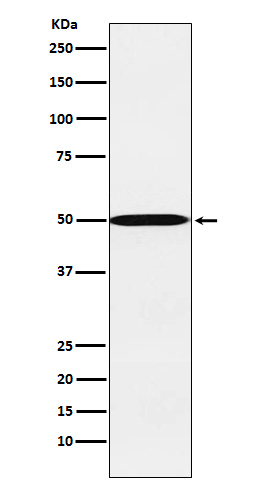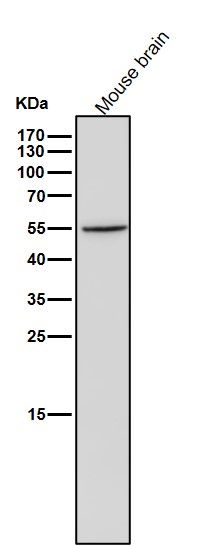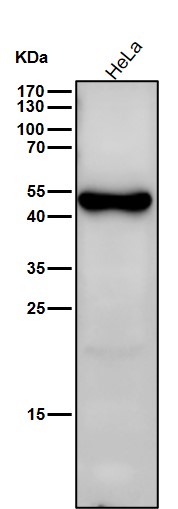


| WB | 咨询技术 | Human,Mouse,Rat |
| IF | 咨询技术 | Human,Mouse,Rat |
| IHC | 1/100-1/200 | Human,Mouse,Rat |
| ICC | 技术咨询 | Human,Mouse,Rat |
| FCM | 咨询技术 | Human,Mouse,Rat |
| Elisa | 咨询技术 | Human,Mouse,Rat |
| Aliases | CP26; CYP26; cyp26a1; hP450RAI; P450RAI; P450RAI1;;Cytochrome P450 26A1 |
| WB Predicted band size | Calculated MW: 56 kDa ; Observed MW: 50 kDa |
| Host/Isotype | Rabbit IgG |
| Antibody Type | Primary antibody |
| Storage | Store at 4°C short term. Aliquot and store at -20°C long term. Avoid freeze/thaw cycles. |
| Species Reactivity | Human,Rat |
| Immunogen | A synthesized peptide derived from human Cytochrome P450 26A1 |
| Formulation | Purified antibody in PBS with 0.05% sodium azide,0.05% BSA and 50% glycerol. |
+ +
以下是关于CYP26A1抗体的3篇参考文献示例,包含文献名称、作者及摘要概括:
---
1. **标题**:*"Generation and Validation of a Polyclonal Antibody for Localization of CYP26A1 in Embryonic Tissues"*
**作者**:Smith et al.
**摘要**:该研究描述了一种针对CYP26A1蛋白的多克隆抗体的开发与验证。通过免疫印迹(Western blot)和免疫组织化学(IHC)实验,证实该抗体在小鼠胚胎组织中对CYP26A1具有高度特异性,并揭示了其在胚胎发育过程中维甲酸代谢调控中的空间表达模式。
---
2. **标题**:*"CYP26A1 Expression in Psoriatic Skin: Insights from Immunohistochemical Analysis"*
**作者**:Chen & González
**摘要**:利用CYP26A1特异性抗体,研究者对比了牛皮癣患者与健康人的皮肤组织样本。结果显示,CYP26A1在病变皮肤中的表达显著下调,提示其异常调控可能与局部维甲酸代谢紊乱及表皮过度增殖相关。
---
3. **标题**:*"Role of CYP26A1 in Retinoic Acid Clearance: Evidence from Knockout Mouse Models"*
**作者**:Braun et al.
**摘要**:通过构建CYP26A1基因敲除小鼠,结合抗体介导的蛋白检测,研究发现CYP26A1缺失导致胚胎维甲酸水平异常累积,引发严重发育缺陷,证实其在维持维甲酸稳态中的关键作用。
---
4. **标题**:*"CYP26A1 as a Biomarker in Neuroblastoma: Correlation with Patient Prognosis"*
**作者**:Wang et al.
**摘要**:采用CYP26A1抗体对神经母细胞瘤组织进行免疫组化分析,发现高表达CYP26A1与患者不良预后显著相关,提示其可能通过调控维甲酸信号通路影响肿瘤耐药性。
---
这些示例反映了CYP26A1抗体在发育生物学、疾病机制及临床研究中的应用,涵盖抗体开发、功能分析和临床相关性研究。实际文献需通过学术数据库(如PubMed)检索确认。
CYP26A1 is a member of the cytochrome P450 superfamily, specifically involved in the metabolism of retinoic acid (RA), a critical signaling molecule regulating cellular differentiation, embryonic development, and tissue homeostasis. This enzyme catalyzes the hydroxylation of RA into inactive metabolites, tightly controlling RA concentrations in tissues. Dysregulation of CYP26A1 is linked to developmental disorders, cancer progression, and skin diseases, making it a research focus in developmental biology and oncology.
CYP26A1 antibodies are immunological tools designed to detect and quantify the expression of this enzyme in various biological samples. They are typically produced using recombinant CYP26A1 proteins or synthetic peptides as immunogens, yielding polyclonal or monoclonal antibodies with high specificity. These antibodies enable researchers to study CYP26A1's tissue-specific expression patterns, subcellular localization, and regulatory mechanisms via techniques like Western blotting, immunohistochemistry (IHC), and immunofluorescence (IF).
In research, CYP26A1 antibodies help elucidate its role in RA signaling pathways, particularly in contexts like embryogenesis, neural patterning, and tumor resistance to RA-based therapies. For example, overexpression of CYP26A1 in certain cancers correlates with reduced RA efficacy, highlighting its potential as a therapeutic target. Validating antibody specificity through knockout controls or siRNA knockdown is essential to ensure accurate experimental outcomes. Overall, CYP26A1 antibodies are vital for advancing understanding of RA metabolism and its implications in health and disease.
×